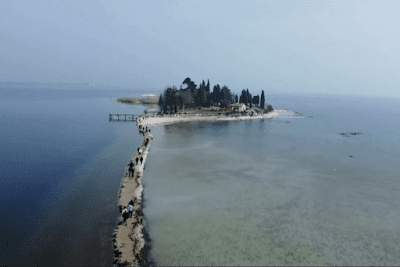The situation is already dire in Italy, but it is beginning to spread to France, Switzerland, and a portion of Austria. “We have 50% of the snow that should be in the mountains,” says Environment Minister Picetto Fratin.
Drought is becoming an issue in a number of European nations. France is bracing for a second summer of water restrictions, but Switzerland, Italy, and parts of Austria are all seeing less snow than usual. The explanation is simple: there hasn’t been much snow in the Alps, and there hasn’t been much rain in recent weeks.
“If the spring weather is similar to that of 2022,” says Josef Eitzinger, an agricultural meteorologist at the University of Vienna, “the drought will grow considerably worse.” Rivers will transport significantly less meltwater than mountains, which is also important for groundwater replenishment.
According to statistics from the national water monitoring system, 125 of the 422 subterranean places detected in France are already at a very low level; 120 are at a low level; and 97 at a moderately low level.
Drought situation in Italy
Things are no better in Italy, on the opposite. Environment Minister Gilberto Pichetto Fratin remarked that “We have 50% of the snow that should be in the mountains, and we are less than half the level of rivers and lakes”. As a result, the government is considering appointing a commissioner with complete authority over water management who does not rule out (far from it) the idea of rationing. “It may well be that in some regions, this is really necessary,” the minister added.
The quantity of snow that has fallen in the Alps since the beginning of the year, according to the Cnr, is less than the typical values for the decade 2011-2021. In Piedmont, practically all rivers dropped, widening the gap with previous years’ flow levels (Sesia -74%, Stura di Demonte -52%, Stura di Lanzo -34%, Toce -46%); only the Pesio and Tanaro showed a moderate rebound, with flows still lower than in 2022 and 77.5% lower than the average.
According to Anbi, the snow cover in Lombardy is about 59% of the historical normal, albeit being greater than previous year (the national association that deals with irrigation water). In Lombardy, water reserves have more than halved (-52.7% on average for the period), and are currently at levels last seen a year ago. The Adda River‘s flow has been progressively declining for months and is now much lower than in prior drier years, indicating a serious problem. Serio and Oglio levels are likewise at their lowest (-15 centimeters on last year and a good 1 meter and 14 centimeters on 2021).
Again, Lake Garda is experiencing a water problem that worsens year after year, with the basin’s level remaining half a meter lower than normal (Isola dei Conigli is now within walking distance). The situation on the Po River is equally severe, with flows below the historical minimum and clearly lower than in 2022.
Although the situation is more encouraging in some regions (most notably Abruzzo), there is cause for concern in general. Additionally, in addition to the possibility of water limitations, drought has an influence on energy output. Because to the lack of rainfall in 2022, hydroelectric power (which meets a significant portion of our demands) fell by 37.7%. With winter coming to a close, the possibility of another dry summer is increasingly concrete.








+ There are no comments
Add yours